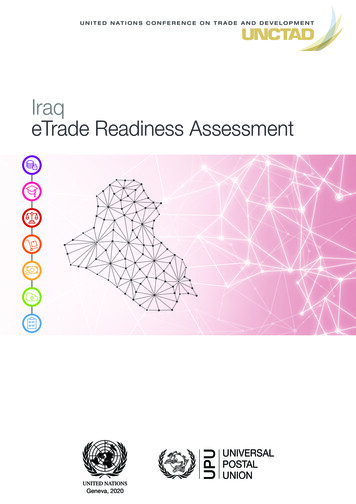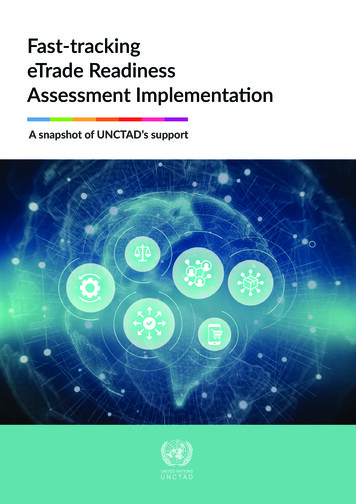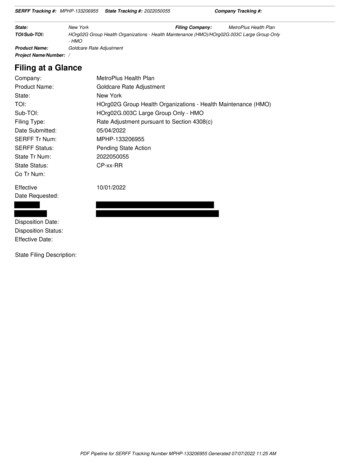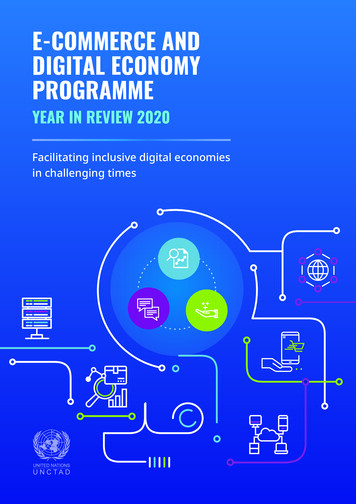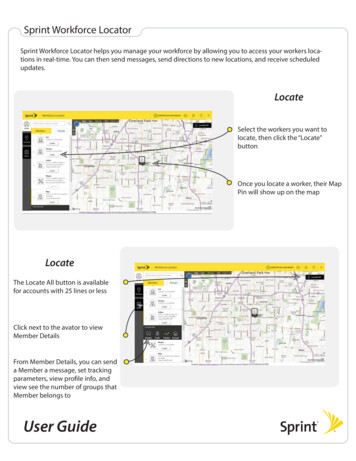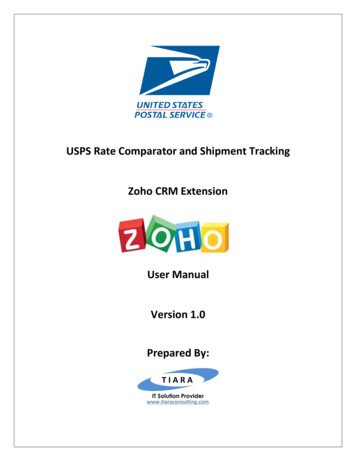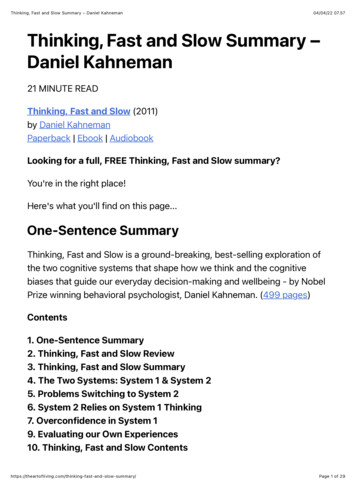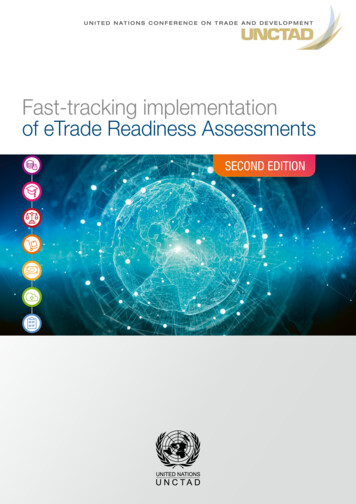
Transcription
Fast-tracking implementationof eTrade Readiness AssessmentsSECOND EDITION
Fast-tracking implementationof eTrade Readiness AssessmentsSECOND EDITIONGeneva, 2022
iiFast-tracking implementation of eTrade Readiness Assessments – Second edition 2022, United NationsAll rights reserved worldwideRequests to reproduce excerpts or to photocopy should be addressed to the Copyright ClearanceCenter at copyright.com.All other queries on rights and licences, including subsidiary rights, should be addressed to:United Nations Publications405 East 42nd StreetNew York, New York 10017United States of AmericaEmail: publications@un.orgWebsite: https://shop.un.orgThe designations employed and the presentation of material on any map in this work do not implythe expression of any opinion whatsoever on the part of the United Nations concerning the legalstatus of any country, territory, city or area or of its authorities, or concerning the delimitation of itsfrontiers or boundaries.This publication has been edited externally.United Nations publication issued by the United Nations Conference on Trade and 13050-8eISBN:978-92-1-001552-3Sales no.:E.22.II.D.21
NoteiiiNOTEWithin the UNCTAD Division on Technology and Logistics, the E-Commerce and Digital EconomyBranch carries out policy-oriented analytical work on the development implications of informationand communication technologies (ICTs) and e-commerce. It is responsible for the preparation ofthe Digital Economy Report (DER) as well as thematic studies on ICT for Development.The Branch promotes international dialogue on issues related to ICTs for development andcontributes to building developing countries’ capacities to measure the information economy andto design and implement relevant policies and legal frameworks. It also monitors the global stateof e-commerce legislation (UNCTAD Cyberlaw Tracker). Since 2016, the Branch has coordinated amulti-stakeholder initiative entitled eTrade for all (etradeforall.org), which aims to improve the abilityof developing countries, particularly least developed countries (LDCs), to use and benefit frome-commerce. The initiative is also behind the UNCTAD eTrade Readiness Assessment and eTradefor Women (eT4W) programmes, launched respectively in 2017 and in 2019.Reference to companies and their activities should not be construed as an endorsement byUNCTAD of those companies or their activities.The following symbols have been used in the tables:Two dots (.) indicate that data are not available or are not separately reported.Rows in tables have been omitted in those cases where no data are available for any of theelements in the row.A dash (-) indicates that the item is equal to zero or its value is negligible.Reference to “dollars” (US ) means United States of America dollars, unless otherwise indicated.Details and percentages in tables do not necessarily add up to the totals because of rounding.
ivFast-tracking implementation of eTrade Readiness Assessments – Second editionPREFACEThe COVID-19 pandemic has been accompanied by a surge in e-commerce and uptake of digitalsolutions by businesses and consumers. It has also underscored the significant divides that existin terms of digital readiness, hampering many countries’ ability to harness e-commerce and thedigital economy.UNCTAD’s eTrade Readiness Assessments (eT Readies) have already helped 29 countries, mainlyLeast Developed Countries (LDCs), to identify the main barriers and opportunities for e-commercedevelopment. But the assessments are only the beginning. Their real value comes to fruition whenmoving from policy recommendations to implementation. That is why UNCTAD set up the eTReady Implementation Support Mechanism (ISM) in 2020. Since then, several capacity-building,knowledge sharing and stakeholder engagement activities have been organized to strengthen incountry implementation capacities and better empower in-country Focal Points, that are playing apivotal role in mobilizing national stakeholders from both the public and private sectors, althoughnot without challenges.This report, the second to review the implementation of the recommendations contained in theassessments, has highlighted 140 new achievements from 14 countries, featuring an averageimplementation rate of 59 per cent, a nine per cent gain compared to the first review. Despitesignificant progress and valuable support provided by eTrade for all partners, this 2nd ImplementationReview highlights areas for improvement. For example, it points to the need to strengthen nationalimplementation arrangements, streamline policy coordination mechanisms and enhance synergiesamong development partners’ interventions. It documents many good practices, policy impactsand lessons learned that can inspire countries and pave the way for further support. It stressesonce more the urgency to accelerate e-commerce enabling reforms and investments to help fostereconomic recovery from the pandemic and increase the resilience to cope with new shocks. Thereport provides a solid basis to help mobilize the much-needed support to advance the e-commercedevelopment agenda in eT Ready beneficiary countries.I would like to thank the Government of Germany for its contribution to the eT Ready ISM, theNetherlands and Switzerland, which are the core donors of UNCTAD’s work on e-commerceand the digital economy. Let me also thank our eTrade for all partners who are contributing withtheir respective expertise in the eTrade Readiness Assessments and renew my call for greaterengagement in the implementation of priority recommendations. From our side, we will advocatefor a more coordinated approach, especially at the country level to enhance synergies, and willcontinue to leverage the role of UN Resident Coordinator Offices to ensure an effective dialogueon the ground and full integration of countries’ priorities in UN Cooperation Frameworks, nationaldevelopment plans and COVID-19 recovery plans. We will continue to connect the dots for a trulyglobal inclusive trade, leaving no one behind in the digital economy.Shamika N. SirimanneDirector, Division on Technology and Logistics
AcknowledgementsvACKNOWLEDGEMENTSThis report is the result of capacity-building support provided by UNCTAD E-Commerce andDigital Economy Branch through the eT Ready Implementation Support Mechanism (ISM) andwas prepared by Alessandro Vitale in collaboration with Laura Cyron, under the overall guidance ofCécile Barayre and Torbjörn Fredriksson.In-country intelligence and stakeholder engagement were ensured by UNCTAD’s network ofeT Ready Focal Points, to whom goes the team’s most sincere appreciation for their proactivecooperation: Md. Hafizur Rahman (Ministry of Commerce, Bangladesh) and Mostafizur Sohel(BASIS, Bangladesh), Riegzieng Om (Ministry of Economic Affairs, Bhutan), Seydou Ilboudoand Boubakar Bilgo (Ministry of Industry, Trade and Handicrafts, Burkina Faso), Chea Laichea(Ministry of Commerce, Cambodia), Serge Bahi and Guillaume Koffi Seka (Ministry of Trade andIndustry, Côte d’Ivoire), Phera Lepati (Ministry of Trade and Industry, Lesotho), Hobisoa LydieIsmaël Ravolahajamanana (Ministry of Industry, Trade and Handicrafts, Madagascar) and GilRazafintsalama (ESTI, Madagascar), Mufwa Munthali (Ministry of Trade and Industry, Malawi),Ibrahim Tanda Bonkano (Ministry of Trade and Private Sector Promotion, Niger), FaramkhaDiop and Assane Diankha (Ministry of Trade and SMEs, Senegal), Alwyn Danitofea (Ministry ofCommunication and Aviation, Solomon Islands), Aïchétou Touré Ali (Ministry of Trade, Industry,Private Sector Development and Local Consumption, Togo), Falaoa Sione, Darryl Ikbal and ToaigaSemisi (Department of Trade, Tuvalu), Chris Matsiko and Augustine Ssekyondwa (respectivelyMinistry of Trade, Industry and Cooperatives and National Information Technology AuthorityUganda, Uganda), Gilbert Chisenga and Akokwa Liwena (Ministry of Commerce, Trade andIndustry, Zambia). UNCTAD also greatly appreciates the involvement of Permanent Missions inGeneva of the countries under review.The report benefited from inputs of eTrade for all partners, namely by the EIF, ERIA, UNCITRAL,UNESCAP, UPU and several Divisions of UNCTAD.Desktop publishing was prepared by Keel Chan and the cover was designed by Magali Studer. Thedocument was externally edited by Nancy Biersteker.Funding for this report was provided by the Government of Germany, the Netherlands andSwitzerland.
Fast-tracking implementation of eTrade Readiness Assessments – Second editionviTABLE OF CONTENTSNOTE. iiiPREFACE. ivACKNOWLEDGEMENTS. vLIST OF BOXES, FIGURES AND TABLES. viiABBREVIATIONS. ixEXECUTIVE SUMMARY. 1INTRODUCTION. 71.eT READY IMPLEMENTATION PERFORMANCE,SUCCESSFUL APPROACHES AND IMPACT HIGHLIGHTS. 111.1 Implementation reviews: a cornerstone of UNCTAD’s ISM. 111.2 eT Ready implementation scored performance assessment. 121.3 Successful approaches and impact highlights in eT Ready implementation. 152.LATEST COUNTRIES’ ACHIEVEMENTS IN THE IMPLEMENTATIONOF eT READY RECOMMENDATIONS IN THE SEVEN POLICY AREAS. 192.1 E-commerce readiness and strategy formulation. 192.2 ICT infrastructure and services. 222.3 Trade facilitation and logistics. 262.4 Legal and regulatory framework. 292.5 Payment solutions. 312.6 Skills development. 342.7 Access to financing. 373.CONNECTING THE DOTS TO ENHANCE eT READYIMPLEMENTATION SYNERGIES. 393.1 The eTrade for all partnership in action. 393.2 Paving the way for scaled up support. 434.LESSONS LEARNED, CONCLUSIONS AND RECOMMENDATIONS. 45ANNEX 1: SCORED PERFORMANCE RESULTS. 47ANNEX 2: METHODOLOGY TECHNICAL NOTE. 49
List of boxes, figures and tablesLIST OF BOXES, FIGURES AND TABLESBOXES1.Acting on lessons learned from the eT Ready 1st IR satisfaction survey. 92.Knowledge and experience-sharing through UNCTAD ISM. 113.Mainstreaming eT Ready recommendations for policy changes in Uganda. 174.Raising the voice of women in policy development. 215.UNCTAD’s Manual for the Production of Statistics on the Digital Economy. 226.Greater international cooperation needed to address the vulnerabilityof undersea cables. 257.Raising the voice and skills of digital women entrepreneurs in Bangladesh. 368.A new e-commerce training course as result of eTradefor all partners’ joint efforts. 419.UN system cooperation in support of a COVID-19 recovery plan in Lao PDR. 4210. The scored performance assessment. 53FIGURES1.eT Ready implementation rates in the 14 countries reviewed in 2021. 22.eT Ready implementation rate by policy areas in the 14 countries reviewed in 2021. 33.Methodology milestones. 84.Implementation rates in the 1st and 2nd IR. 135.Implementation rate by policy area in the 1st and 2nd IR. 146.Implementation approach of countries that participated in both the 1st and 2nd IR. 157.Number of implemented recommendations by country and thematic itemunder policy area “E-commerce readiness and strategy formulation”. 198.Number of implemented recommendations by country and thematic itemunder policy area “ICT infrastructure and services”. 239.Number of implemented recommendations by country and thematic itemunder policy area “Trade facilitation and logistics”. 2610. Scores of the 2021 UN Global Survey on Digital and Sustainable Trade Facilitation(or latest available, marked with *). 2811. Number of implemented recommendations by country and thematic itemunder policy area “Legal and regulatory framework”. 3012. Number of implemented recommendations by country and thematic itemunder policy area “Payment solutions”. 3213. Number of implemented recommendations by country and thematic itemunder policy area “Skills development”. 3414. Number of implemented recommendations by country and thematic itemunder policy area “Access to financing”. 3715. Example of a country profile. 52vii
Fast-tracking implementation of eTrade Readiness Assessments – Second editionviiiTABLES1.Overview of countries’ responses outlining ongoing projects andfuture priorities by policy area. 392.Overview of countries’ priority projects for further support, by policy area. 433.Status of participation of eT Ready beneficiary countries inthe implementation reviews. 494.List of thematic items under each policy area usedto assess eT Ready implementation performance. 51
NCDFUNCTADUNDPUNESCAPUPUAfrican Development BankAutorité de Régulation des Communications Electroniques et des Postes (Togo)Association of Southeast Asian NationsBangladesh Women Chamber of Commerce and IndustryCentral Bank for Western African StatesCustoms declaration systemWest African Committee of Banking and Financial Organization andStandardizatione-Commerce Association of BangladeshEast African CommunityEconomic Community of West African StatesEnhanced Integrated FrameworkEconomic Research Institute for ASEAN and East AsiaForum Inclusif sur le Commerce Electronique au Burkina FasoInnovation Design and Entrepreneurship AcademyImplementation ReviewImplementation Support MechanismInternational Trade CentreMegabyteMalawian KwachaMicro-, Small- and Medium-sized EnterpriseNational Trade Facilitation CommitteesOperational Readiness for E-commercePacific Digital Economy ProgrammePacific Islands Forum SecretariatRegional Comprehensive Economic PartnershipResident Coordinator OfficeStratégie Nationale de Développement du Commerce Electronique au SénégalSmall and medium enterpriseSociété des Postes du TogoWest African Economic and Monetary UnionUnited Nations Capital Development FundUnited Nations Conference on Trade and DevelopmentUnited Nations Development ProgrammeUnited Nations Economic and Social Commission for Asia and the PacificUniversal Postal Union
xFast-tracking implementation of eTrade Readiness Assessments – Second edition
Executive summary1EXECUTIVE SUMMARYSince 2017, UNCTAD has been pioneering eTrade Readiness Assessments (eT Readies)that have helped 29 countries identify the main barriers and opportunities for e-commercedevelopment. Many of them, as documented in this report, have already made significant progressin the implementation of the measures recommended in eT Readies. Now more than ever, fasttracking the implementation of the eT Readies recommendations is a necessity for developingcountries, especially LDCs, to harness the potential of the digital economy as part of inclusiverecovery strategies from the COVID-19 pandemic.UNCTAD set up the eT Ready Implementation Support Mechanism (ISM) in 2020 with aview to supporting beneficiary countries. Through the ISM implementation reviews are regularlyconducted, to build in-country capacities for effective implementation, based on the principlesof country ownership, inclusivity, and results-based management. The Implementation Reviewdone in 2020 was the first of its kind and allowed to capture the progress made by 13 eT Readybeneficiary countries. It formed the basis of further capacity-building, knowledge sharing andstakeholder engagement activities that have helped to raise the profile of e-commerce in nationaland regional development agendas.1The 2nd Implementation Review (IR) was done in 2021 with an improved methodology,building on the lessons learned and feedback received by the different stakeholders involved inthe first implementation review process. It highlights 140 new achievements from 14 countriesthat have participated in the 2nd IR, gathered through an in-depth review of the data collectedfrom in-country stakeholders by the eT Ready Focal Points, in collaboration with a wide range ofstakeholders from line ministries, regulatory agencies and private sector entities. The 2nd IR wascompleted in early 2022 with the publication of this report.The results of the scored performance assessment have confirmed Cambodia as thetop-performer country with an implementation rate of 92 per cent, followed by Bhutan,Senegal and Togo all standing at 81 per cent. The eight countries that have participated in boththe 1st and 2nd IR, namely, Bhutan, Burkina Faso, Cambodia, Madagascar, Senegal, Togo, Ugandaand Zambia have, at varying degrees, made efforts to strengthen areas where achievements wererecorded in the previous year, while also expanding into new areas. Bhutan stands out as thecountry that has taken the highest number of new actions, and as a result, recorded the highestincrease from the 1st to the 2nd IR, moving from 50 to 81 per cent. Among the reviewed countriesthat have more recently completed their eT Ready between 2020 and 2021, namely Côte d’Ivoire,Malawi, Niger and Tuvalu, the average implementation rate stands at 35 per cent. Overall, theaverage implementation rate for the 14 countries reviewed stands at 59 per cent.1The 1st IR was published in 2020 Fast-tracking implementation of eTrade Readiness Assessments UNCTAD.For an overview of the ISM, please refer to Fast-tracking eTrade Readiness Assessment Implementation: Asnapshot of UNCTAD’s support UNCTAD
Fast-tracking implementation of eTrade Readiness Assessments – Second edition2Figure 1eT Ready implementation rates in the 14 countries reviewed in 2021(Percentage)eT Ready done before June 201992eT Ready done after June : UNCTADExperience from the top-performers, Cambodia, Bhutan, Senegal and Togo, has stressed howstrong political leadership at the Government level, exercised by a championing ministry, hashelped to ensure stakeholder mobilization, all key to fast-track implementation.In Cambodia the Ministry of Commerce recognizes the catalytic role played by the eT Ready forseveral government initiatives in support of the e-commerce ecosystem. One recommendationprioritized by the Royal Government of Cambodia was to develop a national E-commerce Strategy.The growing importance of e-commerce in the South-East Asian nation has prompted theGovernment to develop a Digital Economy and Society Policy Framework 2021-2035, which setsout a long-term vision to build a vibrant digital economy and society.In Bhutan, the Policy and Planning Division established a Task Force in 2019 within the Ministryof Economic Affairs that has brought together a broad range of stakeholders from the public,regulatory and private sector sides. It worked to strengthen the policy and governance frameworkof the e-commerce development agenda and contributed to shape a national E-commerce Policyin 2021.In Senegal, the eT Ready helped to catalyze the adoption of a strategic framework to promote thedevelopment of e-commerce and the digital economy. This framework is now an integral part ofthe implementation approach of the National Strategy of Senegal for E-Commerce Developmentled by the Ministry for Trade and Small and Medium Enterprises. Building on solid ground, thegovernment has made strides in building IT infrastructures, increasing power generation capacity,as well as in helping digital entrepreneurship to thrive through passing of a Start-up Act.In Togo, the eT Ready conducted in 2018 was the first framework for public-private sector dialogueon e-commerce, which has since then flourished. Strengthening the legal framework on dataprotection and cybersecurity infrastructure became a top priority, which led to the adoption of newlaws and the establishment of an agency to manage cyberthreats. In November 2021, the Ministryof Trade validated a national e-commerce strategy, which bodes well for a further coordinatedapproach to support the fast-growing Togolese e-commerce ecosystem.In addition, good management practices have emerged and are proving to be useful tosustain the implementation process. Countries have integrated the eT Ready recommendationsinto their policy development mechanisms and used the assessments as working documentsto inform strategies, policies, laws and regulations. However, only half of the reviewed countries
Executive summary3have implemented some form of monitoring mechanism to track progress in their e-commercedevelopment. Most of the countries have officially launched the eT Readies in national events,useful to build ownership. The support provided by UNCTAD and UN Resident Coordinator Offices(UN RCOs) have helped mobilize development partners, which in some cases, such as in Côted’Ivoire and Malawi, led to follow-up discussions and initiatives to coordinate resource mobilizationfor priority projects.The eT Readies have been instrumental in fostering national and regional e-commercestrategies. Cambodia, Kiribati, Nepal, Senegal and Togo have developed e-commerce strategies,Bangladesh and Bhutan have rather opted for a national e-commerce policy. In Benin, Myanmar,Samoa, Solomon Islands, Uganda and Zambia, the development of e-commerce strategies orpolicies are at different stages of development. Among the feedback received from the 2nd IR,Uganda reported to be better equipped with a stronger analytical basis to engage at the regionallevel during the development of the East African Community (EAC) e-Commerce strategy in 2021.Similarly, the Economic Community of West African States (ECOWAS) Commission, jointly withWest African Economic and Monetary Union (WAEMU), has taken stock of the findings of theUNCTAD eTrade Readiness Assessments carried out in the region to start developing a strategicregional vision for e-commerce development. The ECOWAS Commission has formally requestedUNCTAD’s assistance to develop a regional e-commerce strategy, which officially kicked off inOctober 2021. The Pacific Islands Forum Secretariat (PIFS) has developed a regional e-commercestrategy using eT Readies as diagnostic tools and has associated with several eTrade for allpartners in its implementation. As a follow-up to the work UNCTAD conducted in the region,UNCTAD is partnering with the United Nations Capital Development Fund (UNCDF) and the UnitedNations Development Programme (UNDP) in the Pacific Digital Economy Programme (PDEP) withan E-commerce Strategy under way in Solomon Islands.The 2nd IR has documented 140 new actions undertaken by 14 reviewed countries that haveresulted in implementation achievements across the 26 thematic items that are more commonlyaligned to the countries’ eT Readies recommendations. These are broken down by the sevenpolicy areas. Looking more specifically into the seven policy areas, ICT infrastructure and services,legal and regulatory framework and payments are the areas where most of the implementationefforts were concentrated according to the 2021 review, while access to financing is an area whereprogress has been more sluggish.Figure 2eT Ready implementation rate by policy areas in the 14 countries reviewed in2021(Percentage)776453635652Source: UNCTADgstcesAcSkillsdeo fivelonanpmecinntsionlutsontymePaEan -cod s mmtra erteg cey f reaorm diula nesICTtio istLeicsgalandregulatoryframework36
Fast-tracking implementation of eTrade Readiness Assessments – Second edition4There are encouraging developments in the area of e-commerce readiness and strategyformulation. A growing number of countries are working towards adopting, or have alreadyadopted, policy and strategies specific to e-commerce. However, the majority of eT Readybeneficiary countries do not yet have a full-fledged policy or strategy dedicated to e-commerce,and even when a strategy is in place, the gender dimension is rather weak, if not absent.Furthermore, seven countries in the 2nd IR report indicate that they have functioning e-commercecommittees or working groups to oversee and coordinate developments of the sector. Often thecommittees’ membership extends beyond the public sector to include private sector and civilsociety organizations. A similar picture is offered with respect to private sector associations specificto e-commerce players, which help them represent their interests more broadly. Spurred by theCOVID-19 pandemic, the IR shows an expansion of e-government services in 2021. Finally, apersistent gap in most countries is the systematic measurement and development of statisticsregarding e-commerce and the digital economy.E-commerce development is constrained by the lack of affordable and available ICT infrastructureand services. The gap of individuals’ Internet use in LDCs relative to developed countries hasdecreased over the past year. According to ITU estimates, between 2019 and 2021, Internet usein Africa and the Asia-Pacific region jumped by 23 per cent and 24 per cent, respectively, and nowaccounts for 33 and 61 per cent, of their respective populations. Looking at LDCs, the numberof Internet users stands at 27 per cent of the population. However, the gender and urban/ruraldisparities remain significant. On average, only 19 per cent of women are using the Internet inLDCs, 12 percentage points lower than men.2A broad range of public and private initiatives are supporting the effort towards greater coverage, aswell as more reliable and affordable access to the Internet and ICT. Nearly all countries reviewed areundertaking ICT infrastructure development projects, from improved fibre optic networks, expandedtelecommunication tower networks to submarine connections. Furthermore, the coverage andservice options of mobile Internet are expanding, and more countries are moving towards theBroadband Commission for Sustainable Development’s target of entry-level broadband access atprices below two per cent of monthly per capita income. However, even when such target is met,the lowest income groups in a country can still be priced out of affordable service. Countries arecomplementing their ICT infrastructure development by strengthening their electrical grids, shiftingtowards renewables and developing new sources of electricity.E-commerce strongly relies on extensive last-mile logistics and improved trade facilitation measures.Relatively few new initiatives in the area of trade facilitation and logistics were observed in thisreview, in part driven by limitations due to COVID-19 restrictions. The lack of physical addressingsystems remains a major bottleneck, with only limited progress recorded by the reviewed countries.Some countries have taken new actions to expand the network of pick-up centres, in Malawi andSenegal, and to promote the digital transition of the nationa
solutions by businesses and consumers. It has also underscored the significant divides that exist . UNCTAD's Manual for the Production of Statistics on the Digital Economy. 22 6. Greater international cooperation needed to address the vulnerability . Scores of the 2021 UN Global Survey on Digital and Sustainable Trade Facilitation (or .
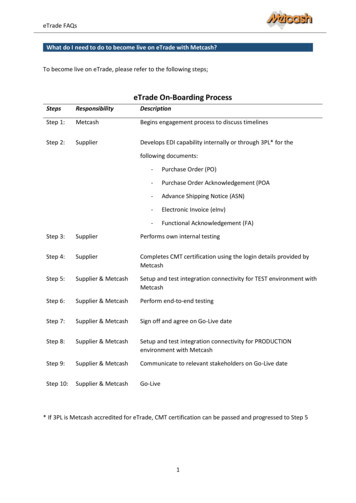
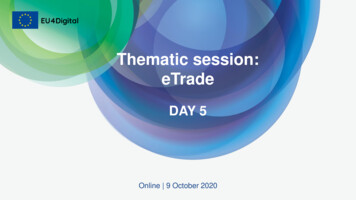

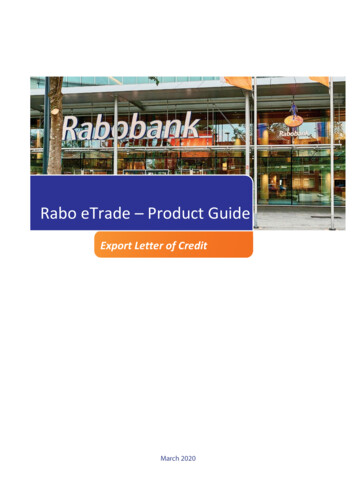
![Kenya: eTrade Readiness Assessment [ADVANCE COPY]](/img/24/dtlecdc2022d2-en.jpg)
